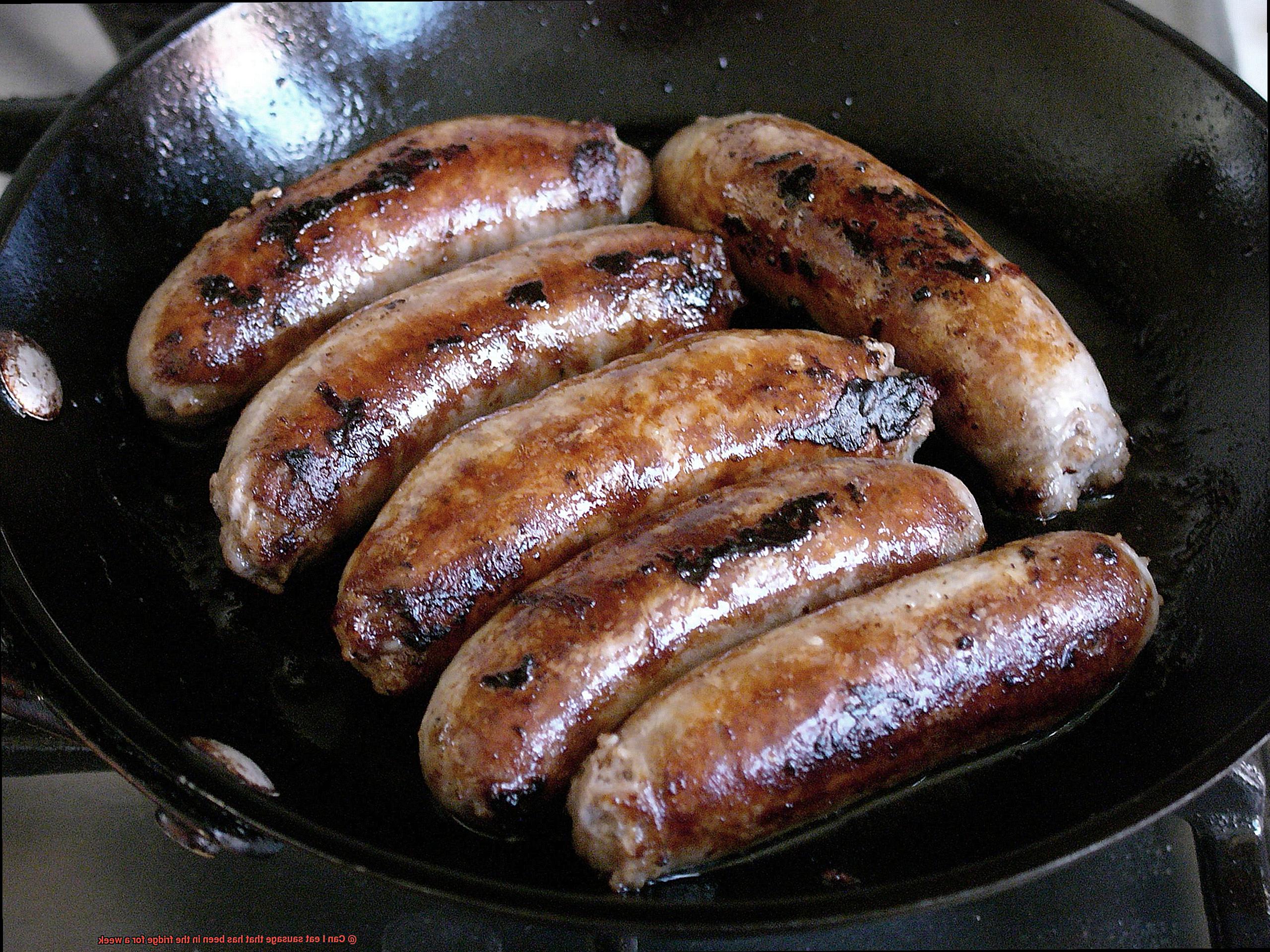Welcome to the world of food safety, where we tackle the tough questions that keep us up at night. Today’s topic? The age-old question of whether or not it’s safe to eat sausage that’s been in the fridge for a week. We’ve all been there – you buy a pack of sausages with good intentions, but life gets in the way and suddenly they’re on their last legs.
But fear not. Before you toss those tasty links in the trash, let’s take a closer look at what happens to food when it sits for too long. We’ll explore the fascinating world of microbial processes and how they can impact your sausage’s safety. Plus, we’ll dive into different types of sausages and how they should be stored to stay fresh and delicious.
But wait, there’s more. We’ll share some pro tips on how to extend your sausage’s shelf life and avoid any potential risks when consuming meat that’s been hanging around for a while. So sit tight, grab a snack (maybe not sausage), and get ready to become a food safety expert.
Contents
What is Sausage?
Sausage is more than just a simple meat product – it’s a versatile and delicious food that has been enjoyed for centuries by people all around the world. From Italian sausage to breakfast sausage, this savory meat is a popular choice among food lovers everywhere.
At its core, sausage is made by grinding meat, seasoning it with herbs and spices, and then stuffing it into a casing. The casing can be made from natural materials such as animal intestines or synthetic materials like collagen or cellulose. Sausage can be made from a variety of meats including beef, pork, chicken, and turkey, and each type has its own unique flavor.
One of the great things about sausage is its versatility. It can be used in countless ways – as a main course, an ingredient in pasta dishes or casseroles, or even as a tasty addition to sandwiches. It’s no wonder that it’s such an essential part of many different cuisines around the world.
However, it’s important to remember that sausage is also a perishable food item that requires proper storage and cooking to prevent the growth of harmful bacteria. When purchasing sausage, make sure to check the expiration date and ensure that it has been stored at the correct temperature. Once opened, sausage should be consumed within a few days or frozen for later use.
Some popular types of sausage include:
- Italian sausage: Spicy and flavorful, this type of sausage is often used in pasta dishes and pizzas.
- Bratwurst: Made with pork or beef, bratwurst is a German-style sausage that is often grilled or roasted.
- Chorizo: This spicy sausage is commonly used in Mexican and Spanish cuisine.
- Breakfast sausage: Mildly seasoned and often made with pork, breakfast sausage is a popular choice for morning meals.
How Long Can I Store Sausage in the Fridge?
How long can you store sausage in the fridge before it goes bad? As an expert, let me break it down for you.

Different types of sausage have similar storage guidelines. Whether you prefer pork, chicken, turkey, or beef sausage, raw sausage should be consumed or frozen within 1-2 days of purchase. Cooked sausage can last up to 4-5 days in the fridge.
The way your sausage is packaged can make a difference in its longevity. Vacuum-sealed sausage may last longer than if it’s just wrapped in plastic or stored in a paper bag. Regardless of packaging, your fridge should be set below 40°F to prevent spoilage.

To prevent bacteria growth, keep the sausage in its original packaging or transfer it to an airtight container. This will preserve its flavor and prevent odors from spreading to other foods in your fridge.
If you’re unsure about the safety of your sausage after being stored for a week, trust your senses. Check for any signs of spoilage such as a sour or funky smell or slimy texture. Always err on the side of caution and throw it out if in doubt.
Here are some additional tips to ensure safety and freshness:
- If you’re not planning on consuming the sausage within a few days, freeze it instead.
- Label the package with the date of purchase so you can keep track of how long it’s been in the fridge.
- Don’t let cooked sausage sit at room temperature for more than 2 hours.
- When reheating cooked sausage, make sure it reaches an internal temperature of 165°F.
Types of Sausages and Their Shelf Lives
Sausages are a versatile and popular food item that comes in different shapes, sizes, and flavors. However, not all sausages are created equal when it comes to their shelf life. It is essential to understand the different types of sausages and their respective shelf lives to ensure that you are consuming safe and fresh food. Here are five sub-sections that explain the types of sausages and their shelf lives:
Fresh Sausages:
Fresh sausages are made with raw meat and require immediate cooking or consumption within a day or two. They have a short shelf life of 1-2 days in the refrigerator. It is crucial to cook fresh sausages thoroughly to kill any harmful bacteria present in them. If you plan to store fresh sausages, make sure to place them in an airtight container, label them with the date of purchase, and store them in the coldest part of your refrigerator.
Smoked Sausages:
Smoked sausages are cooked and smoked to give them a smoky flavor. These sausages can last up to two weeks in the refrigerator if stored properly. Smoked sausages can also be frozen for an extended shelf life. To ensure that smoked sausages remain fresh, wrap them tightly in plastic wrap or aluminum foil and store them in an airtight container.

Cured Sausages:
Cured sausages, also known as dry sausages, are dried and cured with salt and spices. These sausages have a longer shelf life compared to fresh and smoked sausages and can last up to several months if stored properly in a cool, dry place. However, it is essential to note that once you open a package of cured sausage, its shelf life decreases significantly. To store cured sausages, keep them wrapped in wax paper or butcher paper and store them in a cool, dry place.
Breakfast Sausages:
Breakfast sausages are small and thin sausages typically served during breakfast meals. They have a shelf life of around seven days when stored in the refrigerator. To maximize the shelf life of breakfast sausages, store them in their original packaging, and keep them in the coldest part of your refrigerator.
Italian Sausages:

Italian sausages are seasoned with fennel seeds, garlic, and paprika, giving them a distinct flavor profile. They can last up to two weeks if stored properly in the refrigerator. To keep Italian sausages fresh, store them in an airtight container or wrap them tightly in plastic wrap or aluminum foil.
Tips for Storing Sausage
Sausage is a flavorful and popular food that can be cooked in various ways, but improper storage can cause it to spoil quickly. To ensure that your sausage stays safe to eat, here are some tips for storing sausage:
Speedy refrigeration or freezing
As soon as you buy or cook sausage, put it in the fridge or freezer. Leaving it out at room temperature can cause harmful bacteria to grow rapidly. If you plan to refrigerate the sausage, store it in the coldest part of your fridge, usually at the back of the bottom shelf.

Use appropriate containers
Store sausage in plastic bags or airtight containers to prevent contamination and keep it fresh. Wrapping the sausage tightly in plastic wrap before putting it in a container will help to prevent air from getting in and causing spoilage.
Label and date
Label and date your sausage so you know how long it has been stored and when it needs to be used by. This will help you keep track of how long it has been stored and prevent you from eating spoiled sausage.
Keep fridge temperature at 40°F or below
To keep your sausage fresh, make sure your fridge is set to 40°F or below. Bacteria can grow more quickly at higher temperatures, which can spoil the sausage.
Freeze for longer storage
If you need to store sausage for more than a few days, freeze it. Sausage can be frozen for up to two months without losing quality. When freezing sausage, make sure it’s wrapped tightly in plastic wrap or stored in an airtight container to prevent freezer burn.
Signs of Spoiled Sausage
It’s essential to know the signs of spoiled sausage, especially if you’ve left it in the fridge for a week or more. Trust us, nothing ruins a good meal like foodborne illness.
One of the most obvious signs of spoiled sausage is a foul odor. If you detect a sour, putrid, or rotten smell emanating from your sausage, it’s time to say goodbye and dispose of it properly. Similarly, any change in color is a clear indication that your sausage has gone bad. Fresh sausage should have a pinkish-red color, but if it begins to turn gray or brownish, it’s past its prime. And green spots or mold? Don’t even think about it.
Texture is another crucial factor to consider when determining if your sausage has gone bad. If it feels slimy or sticky to the touch, bacteria may be thriving on it. And if the casing appears bloated or swollen, it’s likely due to gas production from bacteria – not exactly appetizing.
However, here’s the thing – not all signs of spoiled sausage are easily detectable. Some harmful bacteria that cause foodborne illness don’t produce any visible changes in appearance or smell. That’s why following proper food handling and storage guidelines is crucial to prevent the growth of harmful bacteria.
Can You Eat Week-Old Sausage?
As an expert in food safety, I’m here to guide you through the factors that determine whether or not a sausage is still edible.
Firstly, let’s talk about the type of sausage. If it’s fresh and uncooked, it’s best consumed within two days of purchase. Cooked sausages, however, can last up to four days in the fridge if stored correctly. So, if your sausage has been sitting in the fridge for more than a week, it’s probably best to toss it.
Secondly, let’s consider the temperature at which the sausage was stored. If your refrigerator is set to below 40°F (4°C), then your sausage may have lasted longer than expected. However, if it was left out in room temperature for even a short period, harmful bacteria could have started growing, making it unsafe to eat.
Lastly, use your senses to determine if the sausage is still good to eat. Does it have a putrid smell? Is it slimy or has it changed color? These are all signs that the sausage may have gone bad. Consuming spoiled meat can lead to food poisoning, which is something no one wants to experience.
Food Safety Considerations When Eating Week-Old Sausage
As a certified food safety expert, I am here to guide you through the murky waters of food safety and help you make an educated decision about consuming that bratwurst sitting in your fridge.
The first step is to consider the type of sausage. Fresh sausages like breakfast and Italian sausage should be consumed within three to five days of purchase or preparation. However, if you have cured or smoked sausages like salami or chorizo, they can last up to two weeks in the refrigerator if they are stored appropriately.
Storage is crucial for maintaining the freshness of your sausage. To prevent bacterial growth and keep your sausage moist, store it in a sealed container or wrap it tightly in plastic wrap. Proper storage can extend the lifespan of your sausage, even up to a week.
Although your week-old sausage may appear and smell okay, it may not be entirely safe to eat. Bacteria can grow on food without producing any noticeable changes. Therefore, it’s essential to use your senses and common sense when deciding whether to consume week-old sausage. To be sure, use a food thermometer to check the internal temperature. The USDA recommends cooking all types of sausage until they reach an internal temperature of 160°F (71°C) to ensure any harmful bacteria are destroyed.
drscag8LBKE” >
Conclusion
To sum it up, whether or not you can eat sausage that’s been in the fridge for a week depends on several factors. As we’ve learned, different types of sausages have varying shelf lives and storage requirements. Fresh sausages should be consumed or frozen within 1-2 days of purchase, while cooked sausages can last up to 4-5 days in the fridge. Smoked and cured sausages can last longer if stored correctly.
Proper storage is key to ensuring safety and freshness. This means using appropriate containers, labeling and dating your sausage, keeping your fridge temperature at 40°F or below, and freezing if necessary. It’s also important to use your senses when assessing whether the sausage is still good to eat.
As an expert in food safety, I advise exercising caution when consuming week-old sausage. While proper storage may prolong its lifespan, harmful bacteria can thrive without producing any noticeable changes. Trust your instincts and common sense when deciding whether to consume sausage that has been sitting in the fridge for a week or more.
Remember that food safety is vital for preventing foodborne illness and enjoying tasty meals safely.






